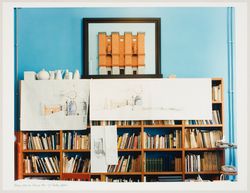dessins, photographies
AP178.S1.2003.PR02.005
Description:
Original file title: Napoli Museu This file includes details of the bathrooms, bookstore, bar, and restaurant.
2003-2006
Details and photographs of the interior of the building, Recupero del Palazzo Donnaregina / Museu de Arte Contemporâneo, Naples
Actions:
AP178.S1.2003.PR02.005
Description:
Original file title: Napoli Museu This file includes details of the bathrooms, bookstore, bar, and restaurant.
dessins, photographies
2003-2006
dessins
AP046.S1.1983.PR01.450
Description:
This file includes main stair hall plans, bookstore furniture, auditorium details, door schedule, gallery details, misc sections and elevations.
1988
Record set, Canadian Centre for Architecture, Montréal, Québec
Actions:
AP046.S1.1983.PR01.450
Description:
This file includes main stair hall plans, bookstore furniture, auditorium details, door schedule, gallery details, misc sections and elevations.
dessins
1988
dessins, documents textuels, photographies
AP178.S1.2003.PR02.027
Description:
Original file title: Fotos Napoli This file includes photographs of the courtyard, as well as drawings and documentation for the bookstore, restaurant, and bar.
circa 2007
Plans and project documentation, Recupero del Palazzo Donnaregina / Museu de Arte Contemporâneo, Naples
Actions:
AP178.S1.2003.PR02.027
Description:
Original file title: Fotos Napoli This file includes photographs of the courtyard, as well as drawings and documentation for the bookstore, restaurant, and bar.
dessins, documents textuels, photographies
circa 2007
dessins
Quantité:
16 File
ARCH43281
Description:
room openings, doors, guard rail, bridge, book store and cashier cage, chemistry laboratory, writing room, screen and lights, window blind recesses, room layout, hat and coat racks, cupboards, entrance canopy, auditorium cornices, bookstore counter, storeroom
Room openings, doors, guard rail, bridge, book store and cashier cage, chemistry laboratory
Actions:
ARCH43281
Description:
room openings, doors, guard rail, bridge, book store and cashier cage, chemistry laboratory, writing room, screen and lights, window blind recesses, room layout, hat and coat racks, cupboards, entrance canopy, auditorium cornices, bookstore counter, storeroom
dessins
Quantité:
16 File
archives
Niveau de description archivistique:
Fonds
Fonds Max Wolfe Roth
AP125
Résumé:
The Max Wolfe Roth fonds, 1933-2000, documents the professional career of architect Max Wolfe Roth. The fonds comprises of materials relating to 15 student projects (1933-1937) and 333 professional projects (1937-2000). Materials in this fonds consist of 7,589 drawings (including reprographic copies), 303 photographs, 22 panels, 2.83 l.m. of textual records, 0.33 l.m.of slides, 82 notebooks, 7 stamps, 1 slide rule and 1 model.
1933-2000
Fonds Max Wolfe Roth
Actions:
AP125
Résumé:
The Max Wolfe Roth fonds, 1933-2000, documents the professional career of architect Max Wolfe Roth. The fonds comprises of materials relating to 15 student projects (1933-1937) and 333 professional projects (1937-2000). Materials in this fonds consist of 7,589 drawings (including reprographic copies), 303 photographs, 22 panels, 2.83 l.m. of textual records, 0.33 l.m.of slides, 82 notebooks, 7 stamps, 1 slide rule and 1 model.
archives
Niveau de description archivistique:
Fonds
1933-2000
documents textuels
ARCH256209
Description:
21 files - cost estimates, time changes, budget, specifications, Stage II requirements, Alma Mater Society request for space, Who's Where Directory, campus planning, bookstore, zoning by-laws, miscellaneous engineers correspondence, space management, International Center reports, Student Union renovation costs, documentation and articles, camera club, food services, music pre-programming notes.
1972-1973
Budget, specifications, Stage II requirements
Actions:
ARCH256209
Description:
21 files - cost estimates, time changes, budget, specifications, Stage II requirements, Alma Mater Society request for space, Who's Where Directory, campus planning, bookstore, zoning by-laws, miscellaneous engineers correspondence, space management, International Center reports, Student Union renovation costs, documentation and articles, camera club, food services, music pre-programming notes.
documents textuels
1972-1973
Examiner les livres de toute bibliothèque personnelle révèle des processus, des influences et des façons de penser de leur propriétaire, ainsi que les surprises cachées dans ses travaux. Tandis que les historiens démêlent des archives, le CCA invite des architectes contemporains à choisir dix ouvrages qui les reflètent.
Librairie du CCA Mot(s)-clé(s):
Konstantinos Pantazis, bibliotheque parlante, libraire
27 mars 2019, 13h30
La bibliothèque parlante : avec Konstantinos Pantazis
Actions:
Description:
Examiner les livres de toute bibliothèque personnelle révèle des processus, des influences et des façons de penser de leur propriétaire, ainsi que les surprises cachées dans ses travaux. Tandis que les historiens démêlent des archives, le CCA invite des architectes contemporains à choisir dix ouvrages qui les reflètent.
Librairie du CCA Mot(s)-clé(s):
Konstantinos Pantazis, bibliotheque parlante, libraire
Joignez-vous à nous pour le lancement de Révéler la ville, un projet collectif de zines réalisé par les participant·es du Collectif des jeunes du CCA. Au cours du dernier mois, les participant·es âgés de 15 à 18 ans ont pris part à des ateliers de recherche, de rédaction et d’édition dirigés par l’équipe des programmes publics, avec la collaboration de l’équipe des(...)
27 novembre 2025, 17h30 à 18h30
Lancement de zine : Révéler la ville / Collectif des jeunes du CCA
Actions:
Description:
Joignez-vous à nous pour le lancement de Révéler la ville, un projet collectif de zines réalisé par les participant·es du Collectif des jeunes du CCA. Au cours du dernier mois, les participant·es âgés de 15 à 18 ans ont pris part à des ateliers de recherche, de rédaction et d’édition dirigés par l’équipe des programmes publics, avec la collaboration de l’équipe des(...)
Projet
AP178.S1.1988.PR01
Description:
This project series documents the Centro Cultural de la Defensa in Madrid, Spain. While the records were held in the office’s archives this project was assigned the number 50/80. The office assigned the date 1988 to this project. An architectural competition was held for the construction of a cultural center and museum for the Ministry of Defense. Seven architects were invited for the first phase of the competition. Four architects, including Fancisco Javier Sainz de Oiza, Lluis Clotet Ballus, Juan Navarro Baldeweg, and Álvaro Siza were selected for the second and final phase. The L-shaped building proposed by Siza included a museum, library, archives, research center, auditoriums, restaurants and bookstores. Siza won the competition but the building was not realized. Documenting this project are sketches, presentation drawings and photographs of model. Textual materials include project documentation, correspondence and articles on the competition.
1988-1990
Centro Cultural de la Defensa - 1º Fase - 2º Fase [La Defensa Cultural Centre, first and second phases], Madrid, Spain (1988)
Actions:
AP178.S1.1988.PR01
Description:
This project series documents the Centro Cultural de la Defensa in Madrid, Spain. While the records were held in the office’s archives this project was assigned the number 50/80. The office assigned the date 1988 to this project. An architectural competition was held for the construction of a cultural center and museum for the Ministry of Defense. Seven architects were invited for the first phase of the competition. Four architects, including Fancisco Javier Sainz de Oiza, Lluis Clotet Ballus, Juan Navarro Baldeweg, and Álvaro Siza were selected for the second and final phase. The L-shaped building proposed by Siza included a museum, library, archives, research center, auditoriums, restaurants and bookstores. Siza won the competition but the building was not realized. Documenting this project are sketches, presentation drawings and photographs of model. Textual materials include project documentation, correspondence and articles on the competition.
Project
1988-1990
Projet
AP056.S1.1988.PR09
Description:
This project series documents renovations and additions to the Art Gallery of Ontario in Toronto from 1988-1993. The office identified the project number as 18703. This project, known as Phase 3, built upon two other major expansion projects to the art gallery, Phase I and Phase II, that were completed by the architecture firm Parkin Architects Planners in the 1970s. Phase 3 was the winning entry for a limited competition won by KPMB, with Thomas Payne as partner-in-charge, in joint venture with the firm of Barton Myers Inc. This project consisted of 100,000 square feet of additions to the building including a prints and drawings study centre, a reference library and administrative offices in the southwest corner and new vaulted galleries, a tower and pyramidal arrival hall along Dundas Street. The Dundas Street elevation was transformed by these additions and brick facades were added. A new double height sculpture atrium, connected to the Victorian Grange mansion, was also added. This project also included 190,000 square feet of renovations to the existing building including changes to galleries, circulation, vaults, staff areas, the restaurant, bookstore and volunteer shop. The goal of these changes was to create a more coherent design between old and new parts of the building and to reinforce the role of art galleries in contemporary life by increasing the scale of the building and creating new spaces for interaction and participation. This project won the Canadian Architect Award of Excellence in 1988. The project is recorded through drawings, photographic materials and accompanying notes dating from 1986-1992. The drawings include site plans and surveys, sketches, plans, elevations, sections, perspectives, details, studies, axonometric drawings, furnishing and structural drawings and some presentation drawings.
1986-1992
Art Gallery of Ontario, Phase 3, Toronto (1988-1993)
Actions:
AP056.S1.1988.PR09
Description:
This project series documents renovations and additions to the Art Gallery of Ontario in Toronto from 1988-1993. The office identified the project number as 18703. This project, known as Phase 3, built upon two other major expansion projects to the art gallery, Phase I and Phase II, that were completed by the architecture firm Parkin Architects Planners in the 1970s. Phase 3 was the winning entry for a limited competition won by KPMB, with Thomas Payne as partner-in-charge, in joint venture with the firm of Barton Myers Inc. This project consisted of 100,000 square feet of additions to the building including a prints and drawings study centre, a reference library and administrative offices in the southwest corner and new vaulted galleries, a tower and pyramidal arrival hall along Dundas Street. The Dundas Street elevation was transformed by these additions and brick facades were added. A new double height sculpture atrium, connected to the Victorian Grange mansion, was also added. This project also included 190,000 square feet of renovations to the existing building including changes to galleries, circulation, vaults, staff areas, the restaurant, bookstore and volunteer shop. The goal of these changes was to create a more coherent design between old and new parts of the building and to reinforce the role of art galleries in contemporary life by increasing the scale of the building and creating new spaces for interaction and participation. This project won the Canadian Architect Award of Excellence in 1988. The project is recorded through drawings, photographic materials and accompanying notes dating from 1986-1992. The drawings include site plans and surveys, sketches, plans, elevations, sections, perspectives, details, studies, axonometric drawings, furnishing and structural drawings and some presentation drawings.
Project
1986-1992

